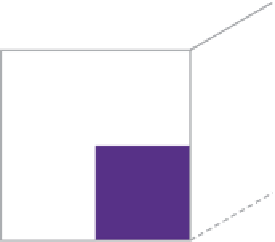Geoscience Reference
In-Depth Information
2UH
operational practices in the mine that are increasing dilution.
In some, ore losses and dilution are accounted for using fac-
tors obtained from some degree of production reconciliation,
and applied to the resource model globally.
A well-planned geostatistical conditional simulation
study, as discussed in detail in Chap. 10 can be used to help
understand dilution and ore loss (Guardiano et al.
1995
;
GeoSystems International
1999
). Such a conditional simula-
tion study can address all three types of dilution.
'LOXWLRQ
P
P
2UH/RVV
7.3
Volume-Variance Correction
:DVWH
Internal dilution is sometimes modeled using geostatistical
tools for volume-variance correction. The most common
distribution shape change methods for volume-variance cor-
rection are the Affine Correction, the Indirect Lognormal,
and the Discrete Gaussian methods. These methods correct a
distribution of a grade attribute sampled at an initial support
(often called the point scale distribution) into an SMU block
distribution. These analytical methods are fast and gener-
ally applicable to small scale changes. Classical references
on these methods include Journel and Huijbregts (
1978
) and
Isaaks and Srivastava (
1989
).
The relationship between volume and variance is shown
in Fig.
7.7
. The variance decreases as the volume increases
due to the averaging out of high and low values. The aver-
aging is affected by the size and shape of the volume, the
continuity of the variable, and the averaging process. For
most variables in mining, since they average arithmetically,
the mean does not change as the volume increases and the
variance of the distribution decreases. There are exceptions,
however, mostly when considering some geotechnical and
metallurgical performance variables.
The point distribution of an attribute will have a larger
variance than the block distribution of the same attribute.
The corrections described in this section apply to the distri-
bution of samples within a chosen estimation domain. The
goal is to take the representative distribution of point scale
data and infer a global block or SMU distribution.
The traditional variance defined in Chap. 2 is the squared
difference of the samples with respect to the overall mean
implicitly states the support size (samples). A more general
Dispersion Variance is defined as:
Fig. 7.6
Schematic of operational mining dilution and ore loss. Dilu-
tion and ore loss are represented for a bench height of 10 m and an angle
of repose of broken ore of 45°. The overall volume of each is 125 m
3
if
a 10 × 10 × 10 m SMU is assumed
Operational Mining Dilution
includes dilution and ore
loss that occurs at the time of mining. Mining equipment un-
avoidably mixes material, because the precision with which
the equipment can follow a dig line is limited, even with
Global Positioning Systems (GPS). If the ore/waste con-
tacts correspond with the geologic contacts, operational and
contact dilution is the same. More commonly, however, the
contacts of ore and waste that occur at the time of mining are
defined in economic terms, and they do not necessarily fol-
low geologic contact zones.
One possible estimate of this type of dilution can be ob-
tained by simple geometric calculations. Figure
7.6
illus-
trates the case of an open pit mine, where the dilution and
ore loss is incorporated into the resources considering a spe-
cific bench height and assuming an angle of repose for the
material. The total metal lost depends on the characteristics
of the contact, including the grade of ore lost and the grade
of the diluting material. A good reference for quantification
of dilution for underground deposits from a mine planning
perspective can be found in Pakalnis et al. (
1995
).
Another source of dilution and ore loss is blast heave and
movement that shifts the position of the material to be mined
and complicates the modeled dig-lines. Significant research
has been done in this area (Yang and Kavetsky
1990
; Harris
1997
; and Zhang
1994
), but to date there are few operations
that attempt to accurately quantify and account for blast
heave.
Ore loss and dilution also occurs when the extracted ma-
terial is transported to the wrong destination: waste sent to
the mill, or ore sent to the dumps. Control equipment such as
GPS and Truck Dispatch systems has reduced the frequency
of this error, but the destination control problem persists and
can be significant.
Sometimes it is important to distinguish between planned
and unplanned dilution; there may be some unexpected
n
1
D vV
2
(, )
=
σ
2
(, )
vV
=
(
z
−
m
)
2
∑
=
(7.4)
iv
,
V
n
i
1
where
v
represents a smaller support such as the sample size,
and
V
represents a larger block support mean value, such as
the stationary population or the SMU-sized block distribution.
The dispersion variance quantifies the reduction in
variance for specific increases in volume. The dispersion

















